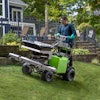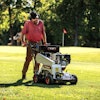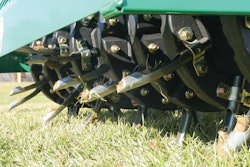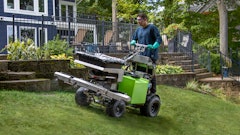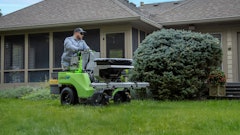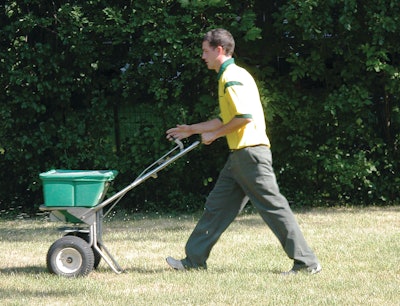
There are many things you can do at the end of summer to prepare your maintenance accounts and outdoor power equipment for the fall season.
“Doing this work now will provide a healthier yard when spring arrives and reduce maintenance required in fall,” says Jeff Linderman, in-house landscaping expert for RepairClinic.com, an online store for replacement parts for outdoor power equipment. Doing some of the tasks listed below will provide a healthier yard in the spring and help reduce fall maintenance.
1. Perk up mulch.
Use a basic yard rake to redistribute mulch. This will enable water to get to the roots faster.
2. Even out mulch around trees.
“A common mistake is to pile mulch tall like a mountain,” warns Linderman. “This makes it more attractive to pests. It’s best to even out the mulch around the trees in the shape of an inner tube, leaving few inches of space between the mulch and the tree.”
3. Use fall fertilizer.
“In most parts of the United States and Canada, fall is the most important time of the year to fertilize lawns,” says Linderman. “Applying fertilizer in fall will result in a far healthier spring lawn.”
4. Repair a damaged lawn.
Late summer provides good opportunity to re-seed bare patches and revitalize dry spots before the temperatures drop and lawn growth slows.
5. Prune wisely.
“Pruning of bushes and other vegetation should be done with great care,” says Linderman. “It’s easy to over-prune. You don’t want to trim away new growth.”
6. Plant spring bulbs now.
In most regions, planting spring bulbs now, rather in than in spring, is wise because it provides a longer period for roots to strengthen.
7. Remove and reuse dried out leaves, twigs and branches.
In lieu of burning them, turn them into nutrient-rich mulch for your lawn.
“It’s easy to create mulch from twigs and branches using a wood chipper,” advises Linderman.
8. Tune-up your lawnmower.
Tune up your lawnmower to improve efficiency, reduce emissions, prevent end-of-summer breakdowns and get it ready for off-season storage.
9. Fix and/or tune-up your leaf blower.
Test your leaf blower(s) and repair any problems to avoid any fall downtime.
10. Prep gas-powered outdoor power equipment for storage by adding fuel stabilizer to fresh fuel.
After adding the fuel stabilizer, run the equipment for a couple of minutes. This will prevent buildup within the carburetor.
11. Remove dead leaves and branches from perennials.
“Clear dead leaves and fallen fruit from your perennials’ living space to reduce its pest appeal,” says Linderman.
12. Aerate.
Aeration is the process of moving air between soil and its surroundings. It plays an important role in the healthy growth of grass. It occurs naturally but the development of thatch (a mix of dead grass and other debris) makes it more difficult for this to happen on its own. Remove small plugs of thatch and soil with an aerating tool.
“Creating passageways will enable greater water intake, make way for valuable microorganisms and worms, maximize the benefits of fertilizer, promote healthier roots and make the lawn more heat and drought tolerant,” Linderman says.
13. Stock up on burlap.
“Burlap is an inexpensive way to prevent weed growth in garden beds,” shares Linderman.
14. Dethatch lawns.
Thatch, which is a layer of dead grass and other debris, can build up on the soil, impeding growth of the grass, blocking water from reaching the roots and creating a haven for fungal diseases. Before fall leaves hit the surface, remove thatch with a rake or dethatcher.
15. Plan for fall colors.
“Even if summer blooms are still thriving, think about mums and other staple fall flowers that you’ll use in their place,” says Linderman.
16. Keep lawns at least two to two and half inches tall.
Cut only one third of grass blade length in a single mowing. Shortening the blades will reduce energy available to obtain nutrients required for healthy root systems.
17. Evaluate properties and plan ahead.
Assess properties and think about what looks good and what needs improvement. Figure out any changes you want to suggest to the homeowner for spring and decide if any could be tackled right away in the fall.
RepairClinic.com has replacement parts for outdoor power equipment like lawn mowers, small engines, string trimmers, edgers, leaf blowers, pole pruners, chainsaws, snowblowers and many others.

